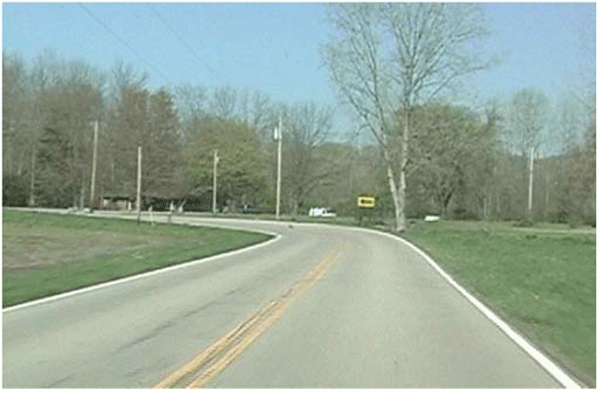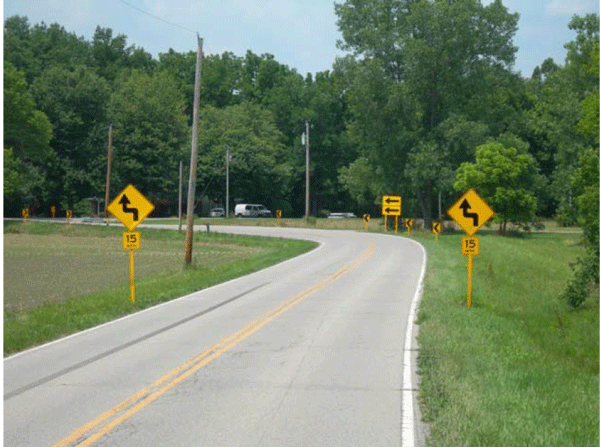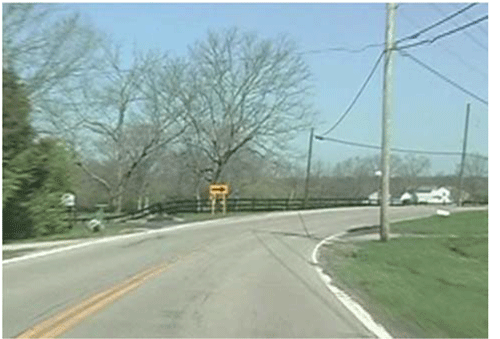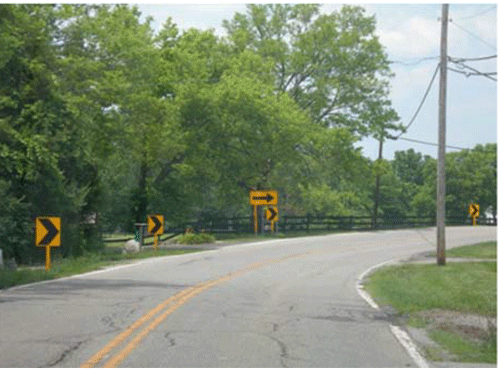Appendix D: Upgrading Curve Signing in Ohio
BACKGROUND
Over 50 percent of Ohio's fatalities involve roadway departure–many of which were a result of high-speed lane departure crashes on the State's rural roads. In response to this issue, the Ohio Department of Transportation developed a systemic program to address roadway departures at curves. In 2010, Ohio DOT introduced a Horizontal Curve Program for state-maintained roads. The agency focused their efforts on upgrading and installing various signage at curves to address the problem. Ohio DOT chose these countermeasures due to the low-cost and their ability to be installed at hundreds of locations by all 12 districts in the State. Ohio oversees 42,250 interstate, U.S., and State route lane miles and maintains approximately 500,000 signs. The 12 districts within Ohio DOT are responsible for maintaining State and Federal roadways. The program was widely accepted by the districts in Ohio, seeing it as a realistic and achievable step to address the high number of fatalities and injuries prevalent along curves. Much of the success of the program can be attributed to effective communication and coordination between the central Ohio DOT office and the districts.

Figure D-1. Photo. A curve on a rural, two-lane road before signage updates through the Horizontal Curve Program.

Figure D-2. Photo. A curve on a rural, two-lane road after signage updates through the Horizontal Curve Program.
PROGRAM DETAILS
To facilitate implementation for the districts, Ohio DOT's central office in Columbus provided each district a list of curve locations ranked by crash frequency. A total of 576 sites were selected by using a threshold of 6 or more crashes over a 5-year period on 0.3 mile segments to flag problematic locations. Next, individual districts conducted site field reviews, evaluated existing conditions and countermeasures onsite, and selected the appropriate signs to be installed at the site. The first round of upgrading curve signage began in 2010 and the districts used funds from High Risk Rural Roads or Highway Safety Improvement Program. Ohio DOT's systematic program is currently implementing additional curve sign upgrades that were developed through an FHWA Roadway Departure Plan, a 2-year program will finish in summer 2015. This effort is funded through other Federal safety dollars that are set aside from Ohio DOT's safety program total each year specifically for systemic improvements.
RESULTS
As of late 2014, Ohio DOT is in the process of analyzing the safety effectiveness of the sign upgrades, starting with the locations treated in 2010. The results of the signage upgrade from the Horizontal Curve Program have been received positively by the general public and local agencies alike. The districts noted that treating problematic curves is easy to implement when the central DOT office provides them with the necessary tools (i.e., the list of high-crash curves and sign order forms). Also, drivers are pleased that the signs provide proper guidance around curves, especially at nighttime.
CONSIDERATIONS
A key aspect of the program's success is the cooperation between the DOT main office and the individual State districts. The central DOT office supplies the data, which allows the districts to focus time and staff on site visits and implementation of the appropriate solutions. For agencies considering a similar program, Ohio DOT emphasized the importance of having a data-driven program. Crash data enables Ohio DOT to generate the crash lists and prioritize locations for Districts to address.

Figure D-3. Photo. A curve on a rural, two-lane road before signage updates through the Horizontal Curve Program.

Figure D-4. Photo. A curve on a rural, two-lane road after signage updates through the Horizontal Curve Program.
CONTACT INFORMATION
Michael McNeill from Ohio DOT provided the information for this case study. Visit http://www.dot.state.oh.us/ for more information. All images are courtesy of Ohio DOT.
